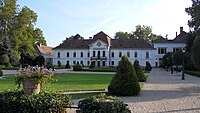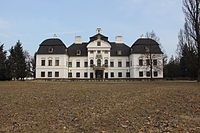|
Győr–Moson–Sopron County
Győr–Moson–Sopron (Hungarian: Győr-Moson-Sopron vármegye, pronounced [ˈɟøːr ˈmoʃon ˈʃopron ˈvaːrmɛɟɛ]; German: Komitat Raab-Wieselburg-Ödenburg; Slovak: Rábsko-mošonsko-šopronská župa) is an administrative county (comitatus or vármegye) in north-western Hungary, on the border with Slovakia (Bratislava region, Nitra region and Trnava region) and Austria (Burgenland). It shares borders with the Hungarian counties Komárom–Esztergom, Veszprém and Vas. The capital of Győr–Moson–Sopron county is Győr. The county is a part of the Centrope project. HistoryGyőr–Sopron county was created in 1950 from two counties: Győr–Moson and Sopron. Though formed as a result of the general Communist administrative reform of that year, it is the long-term result of the impact of earlier border changes on Hungary's western counties. In 1921 the counties of Moson and Sopron were each divided in two, with their western districts together forming the northern half of the Austrian province of Burgenland. Between 1921 and 1945, Győr and Moson became part of the "provisionally and administratively unified counties of Győr–Moson–Pozsony", renamed after 1945 as simply Győr-Moson. In 1947 the borders of this county were modified when Hungary lost three villages in the far north of Győr–Moson to Czechoslovakia as a consequence of the Hungarian peace treaty signed in that year. Though Győr is the capital, there is a strong rivalry between it and Sopron, historically an important cultural centre on its own right. The county also contains Hegyeshalom, Hungary's busiest international land border crossing point. In 1990 it was officially renamed to Győr–Moson–Sopron county. Geography
DemographicsReligion in Győr–Moson–Sopron County (2022 census – of those who declared their religion (60.6%)) Roman Catholic (66.5%) Lutheran (6.6%) Calvinistic (5.8%) Greek Catholic (0.7%) Other Christian denomination (3.3%) Other religion (0.3%) Not religious (16.8%)
Győr-Moson-Sopron is the only county in Hungary whose population has been increasing[when?] according to the Központi Statisztikai Hivatal (KSH). The population density was 111/km2 in 2022.[3]
EthnicityBesides the Hungarian majority, the main minorities are the Germans (approx. 5,000), Roma (3,500), Croats (3,000) and Slovaks (1,500).
Ethnic composition according to the KSH
Ethnicities in Győr-Moson-Sopron County (2018 census, KSH) Hungarians (94%) Germans (3.5%) Gypsies (0.4%) others (1.1%)
ReligionReligious adherence in the county according to 2011 census:[7]
Regional structure
PoliticsCounty AssemblyThe Győr-Moson-Sopron County Council, elected at the 2014 local government elections, is made up of 21 counselors, with the following party composition:[8]
Presidents of the County Assembly
Members of the National AssemblyThe following members elected of the National Assembly during the 2022 parliamentary election:[10] MunicipalitiesGyőr-Moson-Sopron County has 2 urban counties, 10 towns, 4 large villages and 167 villages.
(ordered by population, as of 2011 census)
Gallery
International relationsGyőr-Moson-Sopron County has a partnership relationship with:[11]
ReferencesWikimedia Commons has media related to Győr-Moson-Sopron County. Wikivoyage has a travel guide for Győr-Moson-Sopron County.
External links
|
|||||||||||||||||||||||||||||||||||||||||||||||||||||||||||||||||||||||||||||||||||||||||||||||||||||||||||||||||||||||||||||||||||||||||||||||||||||||||||||||||||||||||||||||||||||||||||||||||||||||||||||||||||||||||||||||||||||||||||||||||||||||||||||||||||||||||||||||||||||||||||||||||||||||||
Portal di Ensiklopedia Dunia















